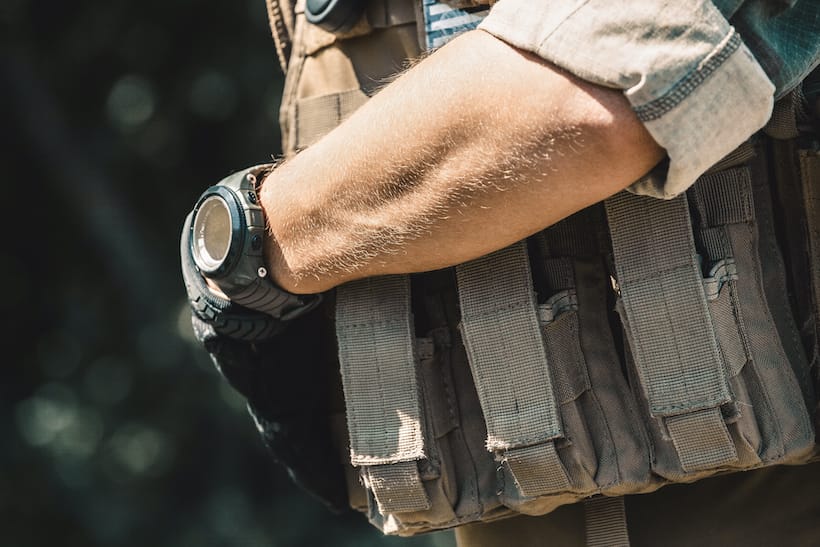Body armor, also known as “bulletproof vest”, is ballistic wear used to stop different projectiles like firearms and shrapnel rated NIJ IIIA Standard and rounds up to 44 magnum.
It prevents ricochets, knife attacks, and other threats from any sort of penetration. Bullet-resistant (bulletproof) vests are available in different varieties of styles, protective materials, sizes, and weights. Let’s see how body armor works.
Types of Body Armor
Fundamentally, we speak about body armor of two types; it can be hard and soft.
The first one appeared as military wear and was a little bit heavy because of the metal inside. Today it is more common to make hard body armor of light materials. They are as durable as metal alloy and can stop rifle shots. A soft bullet-resistant (bulletproof) vest can protect from pistol shots only.

Despite a higher protection level of hard body armor, it is much bulkier. In everyday life, when we do not expect a high risk of attack, it is not necessary. A soft bullet-resistant vest is comfortable in use and can be worn like under a regular shirt or jacket.
What Does a Bulletproof Vest Consist of?
A bulletproof vest consists of plates and synthetic fabric. Both of them protect from hazards associated with firearms and melee weapons.
Hard armor
Hard armor consists of panels made from:
- iron – steel or titanium;
- ceramics;
- composite material like UHMWPE.
Metal plates are the most common but the popularity of ceramics and UHMWPE continues to grow. Of course, armor ceramics are not the same as the cup is made of. They are constructed from layers of high-strength material, which is called “aluminum oxide” or “alumina”. This material is extremely durable and can withstands high temperatures that occur in contact with projectiles.
Composite body armor usually consists of ceramics with high molecular weight polyethylene or aramid base to create higher ballistic protection. Polyethylene is not as strong as ceramics but it makes a bulletproof vest lighter and most comfortable in everyday use.
Soft Armor
Soft armor is made of specific fibers being sewn into vests. These fibers can be interwoven even into clothing. Here is the list of material for making soft body armor:
- Kevlar
- Vectran
- Biosteel
Kevlar belongs to aromatic polyamide – an extremely durable synthetic fiber produced by DuPont. Initially, the material was developed for reinforcing car tires and has been used towards this end until now. When kevlar fibers are interwoven and stacked into layers, they can absorb the energy released because of a projectile and a bulletproof vest contact.
Vectran is an artificial polymer fiber. Being spun from it, a vest stands out for its thermal stability up to 330 C and for its strength that is twice higher than Kevlar has.
primearmor.us
Biosteel is an innovative material produced by transgenic goats. It consists of recombinant spider silk-like protein extracted from the milk of these goats. Biosteel is the most durable substance used in bulletproof vest production.
Resin or plastic often covered the bulletproof vest to make it more durable.
How Does a Bulletproof Vest Hold Up Threat?
Whatever material being used in the production of a bulletproof vest, the principle of how body armor works is the same. When a bullet hits a body armor, the plates inside deform the bullet, absorb its kinetic energy and turn it into heat.
Metal plates extinguish impulses created by the threat impact. The bullet can shatter after hitting this type of body armor and spread across nearby.
The ceramic plate holds up bullets in the same way but it absorbs the bullet fragments inside. A bullet makes in a plate a cavern sized up to three inches. The damaged area will not protect against ballistic threats in the future.
The soft body armor plates consist of strong fibers twisted and tightly woven in a perpendicular weave, which gives the material strength, increased density, and thickness. Intertwined fibers reinforce each other.
When a bullet hits any armor plate, kinetic energy transfers from the bullet to the plate’s surface. The contact area absorbs the energy, transferring it to the surrounding area. A person feels the impact not only in one spot but over a much larger area, which reduces the probability of a serious injury.
Any of the above materials consists of many intertwined layers that reinforce each layer-along with the layers behind it. Each layer slows down the bullet slightly until it stops completely. This also leads to the deformation of the bullet and even shatters it.
Conclusion
Any body armor works similarly. Due to materials with intertwined layers, they slow down a bullet, deform, and shatters. A person will feel the impact but it spreads across a wide area of a vest so that it cannot be a cause of a serious injury.
As usual, military people use hard body armor. In everyday life, soft bulletproof vests are commonly worn. When choosing your protection, remember that the more layers of ballistic material your body armor has, the more protection it provides.